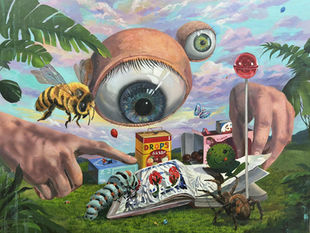
Bridging Tradition and Modernity in Award-Winning Mixed Media Art by KUAN-LANG LAI
KUAN-LANG LAI has achieved remarkable recognition by winning the Gold Prize at the Future Art and Design Award UK 2025 Autumn Season for his project titled "A Monk's Robe of Emptiness." The jury remarked that his work is "original and intricately detailed, beautifully uniting tradition and contemporary expression in a serene harmony."

KUAN-LANG LAI’s artistic journey initially began in the biotech and pharmaceutical R&D field, but over the past few years, he has transitioned to exploring various art forms including calligraphy, seal carving, ink painting, watercolor, mixed media, and pottery. Currently, he is pursuing a Master’s program in Buddhist Art at Huafan University to further strengthen his artistic and theoretical understanding.

Interview
Q: Please give us a brief introduction about yourself and your creative background.
Kuan-Lang: My professional journey began in the biotech and pharmaceutical R&D field, grounded in a scientific background. Over the past few years, however, my focus has transitioned to the arts, exploring various mediums including calligraphy, seal carving, ink painting, watercolor, mixed media, and pottery. To strengthen my artistic and theoretical understanding, I have since returned to school and am currently undertaking an in-service Master’s program in Buddhist Art at Huafan University.

Q: What inspired you to pursue a career in creative / art / design?
Kuan-Lang: My journey into art began by following my wife's lead. Through that process, my own interest was deeply ignited, and I steadily accumulated experience. Given my lifelong passion for religion (such as Buddhism and Taoism) and the humanities, my current aspiration is to create a seamless link between Art and Faith. I aim to use my artistic practice to share spiritual wisdom and to let that wisdom inform my creations. Ultimately, the most important goal is to use this integrated approach to help people reflect, explore their purpose, and face the challenges of life.
Q: Can you describe the creative process behind your work and what motivates you to create?
Kuan-Lang: We can trace the project's inception to this May, when I put the brush to paper for the first character of the "Xinxin Ming" (信心銘, Faith in Mind). However, you could also trace its roots back to 2024 when I began studying Thangka painting and seal carving, or even further to 2018 when I was learning Regular Script (Kaishu) and Clerical Script (Lishu) calligraphy. Yet, my first encounter with the Xinxin Ming and my deep appreciation for its meaning dates back over 30 years. While transcribing the Xinxin Ming this time, I also simultaneously undertook the work of translating it into English. Although many others have translated this text, it is, after all, an ancient Chinese document, and everyone's personal experience and understanding is unique. By translating it, I was able to leave behind my own insights. So, was there a particular idea or moment that sparked the creation of this work? Yes. I created this project and translated the Xinxin Ming because I hope more people can understand and absorb the wisdom within it. I believe this wisdom can aid in the process of thinking, exploring, and confronting one's own life.

Q: What was the most exciting or challenging part of creating the work you submitted to the competition?
Kuan-Lang: The completion of this work was a natural and spontaneous outcome. Whenever I finish a piece, I feel a sense of accomplishment and I'm always happy to share it with others. Of course, participating in an international art competition for the first time felt incredibly new and exciting. The most challenging aspect was the need to stop and engage in a dialogue with myself—to thoroughly examine the origin, motivation, message, and emotions I intended to convey at the moment of creation.
Q: How would you describe your creative style and the key characteristics that define your work?
Kuan-Lang: My creative style is not yet fixed, or perhaps, it hasn't even fully formed. Transitioning from science to art means everything is new and exciting. I have a genuine eagerness to learn, but I don't feel pressure to complete any specific work. I believe that when the time is right, the pieces will naturally unfold and complete themselves. Please look forward to what develops.

Q: What has been your experience participating in the competition? Were you satisfied with the process and results?
Kuan-Lang: The entire process was exceptionally smooth, and the experience was truly wonderful. I am very grateful for the judges' dedication and encouragement.

Q: Where do you see the future of the art and design industry heading in the next 5-10 years?
Kuan-Lang: The widespread use of tools like generative AI is bringing about a revolutionary impact on the art and design industries. The deconstruction or superposition of existing artistic and design styles, as well as the generation and output of artworks and imagery, have become remarkably easy. This shift from quantity to quality means we can anticipate the emergence of creative forms and works that were previously unimaginable. However, this very abundance of information, artwork, and imagery risks leading to visual numbness or apathy in viewers. Furthermore, the rapid pace of modern life makes it difficult for people to slow down and truly appreciate art, potentially causing art to lose its vital purpose of engaging with life. Nevertheless, I believe that ultimately, everyone will seek out a space that belongs uniquely to them—much like a wildflower pushing its way through a crack in the wall.
About the Award
The Future Art and Design Award is an international initiative aimed at celebrating creativity and innovation across diverse artistic disciplines. It honors outstanding contributions in the field of art and design, recognizing artists and creators who push the boundaries of traditional practices and embrace new avenues of expression.






